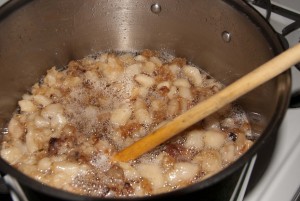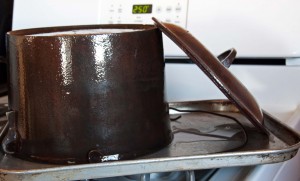 Don rendered lard a few days ago. Not in conjunction with our annual hog butchering, though. We were simply out of lard so Don pulled four bags of chunked-up fat from the freezer, allowed it to thaw, then cooked it down.
Don rendered lard a few days ago. Not in conjunction with our annual hog butchering, though. We were simply out of lard so Don pulled four bags of chunked-up fat from the freezer, allowed it to thaw, then cooked it down.
Over the years, our butchering process has been refined. No longer do we render all the lard at one time. Early on, we used a large cast iron kettle and an old crank-handled lard press. It was tricky to coordinate the right combination of fire temperature and liquid lard consistency before scorching occurred. At the exact right time, the lard had to be ladled out and packaged or the batch would turn brown and take on an off flavor. Now, while butchering, we cut the fat into one inch chunks and freeze them in one gallon quantities. Rendering can be done as needed on the stove top using a heavy, 12 quart pot.
As a side note, we still have the kettle and the press. Both are still in good working condition. The kettle, in fact, is used on occasion to pop up some kettle corn when friends visit.
 Today, Don seasoned a cast iron pot given to us by my dad. After removing rust from the inside and outside of the pot, he washed it in hot, soapy water, thoroughly dried it, smeared it with lard, then baked it in the oven for one hour at 250 degrees and one half hour at 350 degrees. It is now ready to receive the fixings for beef stew.
Today, Don seasoned a cast iron pot given to us by my dad. After removing rust from the inside and outside of the pot, he washed it in hot, soapy water, thoroughly dried it, smeared it with lard, then baked it in the oven for one hour at 250 degrees and one half hour at 350 degrees. It is now ready to receive the fixings for beef stew.